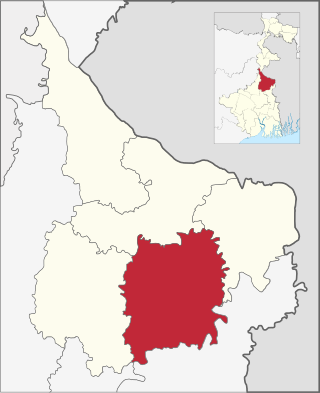Education
Murshidabad district had a literacy rate of 66.59% (for population of 7 years and above) as per the census of India 2011. Barhampur subdivision had a literacy rate of 72.60%, Kandi subdivision 66.28%, Jangipur subdivision 60.95%, Lalbag subdivision 68.00% and Domkal subdivision 68.35%. [14] Given in the table below is a comprehensive picture of the education scenario in Murshidabad district for the year 2013-14: [14]
| Subdivision | Primary
School | Middle
School | High
School | Higher Secondary
School | General
College, Univ | Technical /
Professional Instt | Non-formal
Education |
|---|
| Institution | Student | Institution | Student | Institution | Student | Institution | Student | Institution | Student | Institution | Student | Institution | Student
|
|---|
| Barhampur | 728 | 88,371 | 107 | 13,364 | 37 | 31,214 | 92 | 162,613 | 7 | 17,418 | 11 | 2,796 | 2,278 | 100,164 |
| Kandi | 672 | 66,030 | 105 | 11,248 | 46 | 32,752 | 61 | 87,482 | 5 | 7,830 | 3 | 400 | 1,717 | 74,370 |
| Jangipur | 747 | 144,416 | 72 | 14,159 | 25 | 30,004 | 76 | 194,025 | 5 | 15,335 | 5 | 500 | 2,793 | 160,236 |
| Lalbag | 601 | 72,429 | 74 | 8,997 | 24 | 22,174 | 66 | 120,454 | 5 | 13,088 | 7 | 759 | 2,082 | 93,891 |
| Domkol | 432 | 52,177 | 73 | 11,791 | 22 | 23,201 | 47 | 86,672 | 3 | 7,211 | 11 | 2,457 | 1,612 | 74,330 |
| Murshidabad district | 3,180 | 423,423 | 431 | 59,559 | 154 | 139,345 | 342 | 651,246 | 25 | 60,882 | 37 | 6,912 | 10,482 | 502,991 |
|
Note: Primary schools include junior basic schools; middle schools, high schools and higher secondary schools include madrasahs; technical schools include junior technical schools, junior government polytechnics, industrial technical institutes, industrial training centres, nursing training institutes etc.; technical and professional colleges include engineering colleges, medical colleges, para-medical institutes, management colleges, teachers training and nursing training colleges, law colleges, art colleges, music colleges etc. Special and non-formal education centres include sishu siksha kendras, madhyamik siksha kendras, centres of Rabindra mukta vidyalaya, recognised Sanskrit tols, institutions for the blind and other handicapped persons, Anganwadi centres, reformatory schools etc. [14] The following institutions are located in Kandi subdivision:
Healthcare
The table below (all data in numbers) presents an overview of the medical facilities available and patients treated in the hospitals, health centres and sub-centres in 2014 in Murshidabad district. [23]
| Subdivision | Health & Family Welfare Deptt, WB | Other
State
Govt
Deptts | Local
bodies | Central
Govt
Deptts /
PSUs | NGO /
Private
Nursing
Homes | Total | Total
Number
of
Beds | Total
Number
of
Doctors* | Indoor
Patients | Outdoor
Patients |
|---|
Hospitals
| Rural
Hospitals
| Block
Primary
Health
Centres
| Primary
Health
Centres
|
|---|
| Barhampur | 2 | 2 | 4 | 15 | 3 | - | - | 45 | 71 | 1,645 | 282 | 149,393 | 2,094,027 |
| Kandi | 1 | 2 | 3 | 17 | 1 | - | - | 6 | 30 | 567 | 68 | 85,624 | 1,005,056 |
| Jangipur | 1 | 1 | 6 | 15 | - | - | 2 | 12 | 37 | 590 | 62 | 141,427 | 1,043,548 |
| Lalbag | 1 | 2 | 3 | 14 | - | 1 | 1 | 23 | 45 | 483 | 65 | 105,562 | 1,154,275 |
| Domkol | 1 | 2 | 2 | 9 | - | - | - | 19 | 33 | 252 | 44 | 45,110 | 802,309 |
| Murshidabad district | 6 | 9 | 18 | 70 | 4 | 1 | 3 | 105 | 216 | 2,537 | 521 | 527,116 | 6,099,215 |
|
.* Excluding nursing homes
Medical facilities in Kandi subdivision are as follows:
Hospitals: (Name, location, beds) [24]
Kandi Subdivisional Hospital, Kandi, 250 beds
Home for Lunatic Vagrants, Mahalandi, 10 beds
Rural Hospitals: (Name, block, location, beds) [24]
Burwan Rural Hospital, Burwan CD Block, Burwan, 30 beds
Khargram Rural Hospital, Khargram CD Block, Khargram, 50 beds
Gokarna Rural Hospital, Kandi CD Block, Gokarna, 15 beds
Bharatpur Rural Hospital, Bharatapur I CD Block, Bharatpur, 30 beds
Salar Rural Hospital, Bharatpur II CD Block, Salar, 30 beds
Primary Health Centres: (CD Block-wise)(CD Block, PHC location, beds) [24]
Kandi CD Block: Bahara (6), Purandarpur (10), Lakshmikantapur (2)
Bharatpur I CD Block: Amlai (4), Jajan (10)
Bharatpur II CD Block: Kagram (6), Simulia, Duttabarutia (6), Talibpur (10), Tenya (4)
Burwan CD Block: Kuli (6), Kharjuna (Subaldaha) (4), Panchthupi (10), Sundarpur (10)
Khargram CD Block: Margram (10), Jhili, Nonadanga (10), Parulia, Debiparulia (10), Indrani (2)
This page is based on this
Wikipedia article Text is available under the
CC BY-SA 4.0 license; additional terms may apply.
Images, videos and audio are available under their respective licenses.






